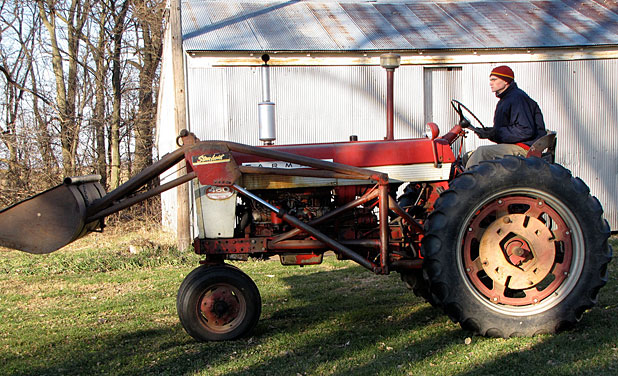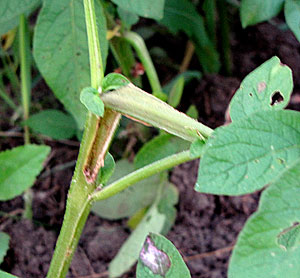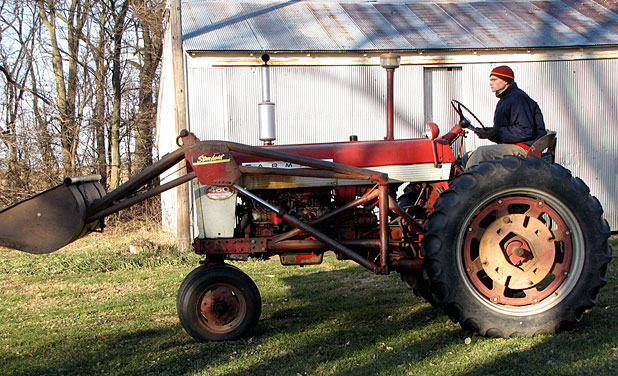 Going off to war against the weed-lurking worms. (Steph Larsen)
Going off to war against the weed-lurking worms. (Steph Larsen)
I’m at war with the common stalk borer. As much as I believe in sustainability and chemical-free agriculture in theory, I’ve never been more tempted to use insecticides as I am right now.
For years, the signature for my email has been a quote from the agtivist-scientist Vandana Shiva, “Sustainability begins with peace with the Earth.” Contrary to current U.S. foreign policy, one cannot be forever at war. Balance is the basis of sustainability in the environment, and anyone who says differently is selling something.
I believe this fully, and you’d have a hard time finding a more staunch supporter of organic and sustainable agriculture than me. It’s my chosen profession after all, and the way I live my life. But even I have my weak moments. When months of hard work and care are being undone by hungry little worms, it’s hard to embrace the rhetoric of balance and harmony. I’m furious, and I want to take it out on the cause of my plants’ distress. Poison seems as good a method of revenge as any.
Our battle with the borers started back in snowy February, when we started seeds in a spare room in our house with a big south-facing window. My partner, Brian, diligently watered them twice a day, and before long we had healthy seedlings. It’s a lot of effort to start your own seeds, but worth it. By May, many of them had made their way into the newly tilled garden.
 A victim of the evil borerIn early June, however, we noticed something was definitely wrong. It started with a pepper plant wilting even though we’d had plenty of rain. It took a few days to discover that the cause was a thin, striped worm boring into the peppers. By the time we wised up to their antics, the buggers had moved to other plants. Anything with a substantial stem was susceptible, so soon we were checking the tomatoes, eggplant, potatoes, basil, squash, and anything else that looked remotely wilty.
A victim of the evil borerIn early June, however, we noticed something was definitely wrong. It started with a pepper plant wilting even though we’d had plenty of rain. It took a few days to discover that the cause was a thin, striped worm boring into the peppers. By the time we wised up to their antics, the buggers had moved to other plants. Anything with a substantial stem was susceptible, so soon we were checking the tomatoes, eggplant, potatoes, basil, squash, and anything else that looked remotely wilty.
After some research, we learned that the common stalk borers’ life cycle starts in brome grass, one of the main weeds in our garden. Brome makes a great forage for our sheep, but it harbors the eggs of the stalk borer. So this weekend, in the 95-degree sun, we did our best to get rid of any weed within 10 feet of our 50-by-50-foot garden. It wasn’t easy: I’ve got the blisters to prove it. But if we hadn’t, all our favorite vegetables could have been lost.
When it comes to agriculture and growing things, my goal has always been to work with nature as much as possible. Live in a desert? Don’t plant cranberries, rice, or anything else that likes “wet feet.” Apple trees like south-facing exposures, watermelon do well in sandy soil…you get the picture. Crops do best in the conditions for which they adapted.
The same can be said for insects — they live in balance with their surroundings. Some bugs are harmful, but they almost always have natural predators. Encourage the beneficial bugs, and your garden will be healthier for it.
But it seems the only predators in my garden for the stalk borers are two-legged.
 This potato used to have a top!As I dropped weeds (and hopefully the borers inside them) into a tub to carry them to the compost pile, head pounding from dehydration, I briefly considered how much easier this would be if I could just spray a little Sevin and be done. A broad-spectrum insecticide, Sevin will do away with most insects it encounters. It would be so much easier than pulling weeds and checking all the plants, and Sevin doesn’t wash off in a heavy rain, so I wouldn’t have to use much.
This potato used to have a top!As I dropped weeds (and hopefully the borers inside them) into a tub to carry them to the compost pile, head pounding from dehydration, I briefly considered how much easier this would be if I could just spray a little Sevin and be done. A broad-spectrum insecticide, Sevin will do away with most insects it encounters. It would be so much easier than pulling weeds and checking all the plants, and Sevin doesn’t wash off in a heavy rain, so I wouldn’t have to use much.
It’s that last part that gives me pause though. The active ingredient in Sevin is carbaryl, a known carcinogen and the chemical behind the disaster in Bhopal in 1984. If it resists coming off in a heavy rain, there will still be residue on my veggies even if I wash them. When carbaryl breaks down, the chemical byproducts are still carcinogenic. Do I really want to ingest this stuff?
Not to mention that carbaryl kills beneficial insects as well as stalk borers. I need ladybugs in my garden to control the aphids, and honeybees to pollinate the squash. Insects are an important part of the environmental equation that equals sustainability, and indiscriminately poisoning them would mean a lot more problems down the road.
The long view of this problem is that while stalk borers might fell a few of the plants we’ve worked hard to nurture, we’d throw our entire garden ecosystem out of balance if we started using pesticides. I’m also not willing to risk harm to my health, my animals, my DNA, or any future offspring. So while I’m tempted to take the easy way out with chemicals, I know I’d be doing more harm than good. To the extent possible, my land will remain organic for as long as it’s mine.
I can’t say, though, that I don’t get a small amount of pleasure from squishing the stalk borers I find. This may not be chemical warfare, but it’s still war.


